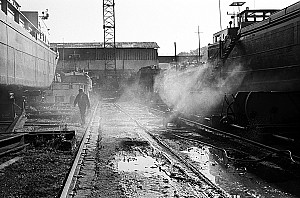réflexion dans le IHT
4 messages
• Page 1 sur 1
| François Stanislas |
|
|
Régulier Messages : 154Depuis le 21 nov 2006 Belgique |
Le post-traitement en High Dynamic expliqué aux novices dans le IHT:
http://tierneylab.blogs.nytimes.com/200 ... s-picture/ Le plus surprenant est la position du journal: ce genre d'images par des photo-journalistes n'aurait pas sa place dans le IHT. Un peu dans le genre "attention, cette jolie fille est traitée sous photoshop". Comme si chaque image n'était pas une "recréation". I am not objective. I show what's going on, I speak my mind, I am human. My pictures tell the truth.
Stanley Greene www.simplyhuman.be |
| danyves |
|
|
Vieux briscard Messages : 4810Depuis le 23 juil 2007 Normandie |
Dans les commentaires
And should the TIMES use HDR in its photos? Only with the lightest of touches, handled by a human artist, which is what the process requires, an artist. Sorry, NYT, but you will have to hire more people and pay them well. |
| danyves |
|
|
Vieux briscard Messages : 4810Depuis le 23 juil 2007 Normandie |
Un des commentaires les plus pertinents
I’m SO tired of hearing that “Photoshopped” images are unacceptable. Photoshop (and the other programs listed here) are simply the digital versions of the old-fashioned darkroom. As a photographer who began making images with black-and-white film (late 1960s), for me the darkroom and its manipulations were standard fare. EVERY image was manipulated, and rightly so (assuming quality is also required). Cameras capture an image that already manipulated via the adjustments (manual or automatic) built into it by the manufacturer’s attempt to help make the perfect image. Why stop there when we (professional photographers) can do better? For news photographers, who are required to display only images that are truthful and accurate, the digital darkroom (as demonstrated in this article), can enhance the camera’s poor attempt into something that truly does show the scene as if the reader were actually present and seeing it “live”. Let news photographers use EVERYTHING. The issue is about ethics, not electronics. It’s HOW they use the tools that determines the integrity of the photographer…and the publication. — Charlie Morey |
| François Stanislas |
|
|
Régulier Messages : 154Depuis le 21 nov 2006 Belgique |
Je dirais que même au-delà du post-traitement (en chambre noire ou digital), le fait de faire une photographie est une interprétation de la réalité. C'est bien entendu un truisme, une évidence, mais le nier en affirmant que dénoncer la retouche des images pour "retrouver" une photographie "vraie" est une imposture.
Chaque photo est une histoire racontée. La littérature n'est pas une succession de faits énoncés mais bien un récit structuré. L'image fonctionne de même et cette structuration des éléments visuels et temporels constitue l'écriture des photographes... qui ne sont pas des photomatons! Quant au photo-journalisme, cette écriture fictionnelle est présente également même si elle est contrainte par des impératifs éthiques plus importants. I am not objective. I show what's going on, I speak my mind, I am human. My pictures tell the truth.
Stanley Greene www.simplyhuman.be |
4 messages
• Page 1 sur 1
Retourner vers Livres, sites, expositions et événements
Qui est en ligne
Utilisateurs parcourant cette section : Aucun utilisateur enregistré et 5 invités




